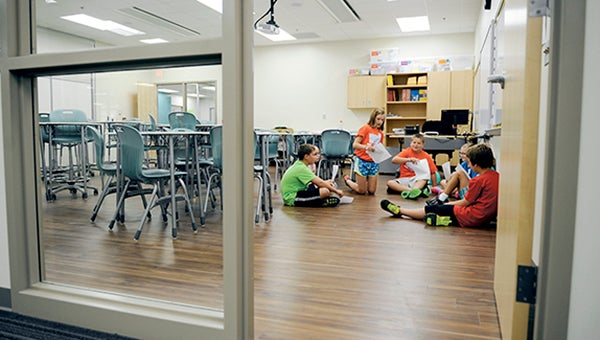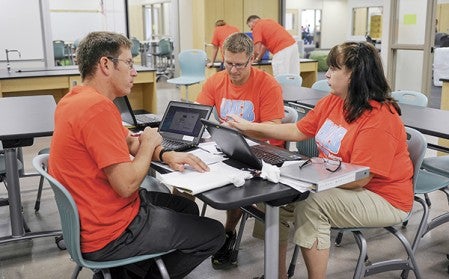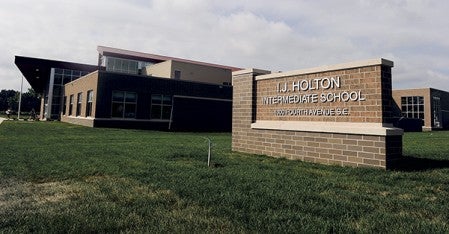I.J. Holton: The new bell
Published 6:02 am Monday, September 2, 2013

Incoming students to I.J. Holton Intermediate School are led Wednesday morning through an exercise design to get to know each other better. Eric Johnson/photodesk@austindailyherald.com
Inside the almost-complete halls of I.J. Holton Intermediate School, fifth- and sixth-grade teachers are getting ready for another school year. They’re setting up classrooms, meeting over shared lesson plans, preparing desks and getting organized — the typical teacher regimen before greeting students once more.
Yet I.J. Holton teachers are breaking the mold when it comes to the standard back-to-school schedule. Science teachers are unpacking microscopes with computer connectivity. Math teachers are dreaming up ways to tear down the walls of their classrooms to teach more than 100 students at a time. Bean bags and high-top desks are dotting common areas throughout the school, and construction workers are putting the last touches on the building.
“A lot of little last things need to be done that are out of our control,” said I.J. Holton Principal Jean McDermott.
For the first time in decades, Austin will have a new school come Sept. 3, the first day of the 2013-2014 academic year.

I.J. Holton teachers Adam Ansorge, left going clockwise, Kyle Bendson and Sarah Shultz plan for the new school year during a work day. Eric Johnson/photodesk@austindailyherald.com
A marathon project
I.J. Holton is the product of more than two years of work by Austin Public Schools and community members in response to a growing student population. District officials learned Austin would welcome more students in 2010, after demographer Hazel Reinhardt completed a district study. Reinhardt told district officials that Austin schools would grow by more than 400 students over a five-year period, based on Mower County birth records.
“I don’t think people realized the degree to which our schools increased,” said Mark Stotts, finance director.
Yet the Austin Public Schools board grew concerned in November 2010 after an internal study showed all Austin schools except for Austin High School were over capacity; some schools such as Southgate Elementary had to convert closets and storage space into classrooms to fit students.
The board commissioned a facilities task force to tackle the problem by asking about 40 area educators, elected officials and community members to come up with potential solutions.
“ We wanted to include the public from the very beginning,” Austin Superintendent David Krenz said.
The task force worked over a four-month period to come up with the seemingly obvious answer: The district needed a new school.
Stotts was the chief coordinator behind the task force and gathered necessary information for task force members. He didn’t know how the task force’s work would turn out — he has repeatedly said any answer to the district’s overcrowding issue had to come from community members — but he knew the task force would come up with constructive solutions once members realized how much of an impact an extra 400 students over a few years’ time could be.
“Getting the task force to buy into the demographics study was key,” he said. “Once the task force agreed that yep, we were going to have growth, things went a lot more smoothly in terms of developing a plan.”
The task force whittled 23 potential ideas into a plan for a fifth- and sixth-grade building, in order to ease student populations at Austin elementaries as well as Ellis Middle School. By the summer of 2011, district officials had proposed a 20-year, $28.9 million bond referendum, higher than the previous $20 million referendum to pay for AHS renovations in the 1990s.
The referendum was lower than the district’s original $34 million projections for a new school, which fit in with the district’s public goal to keep the referendum lower than $30 million. It would go toward the new school as well as a $2 million expansion and renovation at Woodson Kindergarten Center.
The proposal sparked plenty of discussion throughout Austin, as many residents questioned whether the district could refit one of Austin’s older structures — a move which district officials say likely would have cost more money, since any existing building would have to be brought up to code as well as fit existing state mandates concerning school buildings.
Yet more referendum supporters came to voting polls in November 2011 than critics. The referendum passed 2,971 to 2,543 — a margin of 428 votes.
From there, the district began the new school process. District officials hired architects while administrators researched the potential of creating a Science, Technology, Engineering and Math school.
Within months, McDermott was hired to head the new school while the Joseph Company broke ground on the new school. Though district officials had decided on building plans and the Austin Public Schools board was set on a new name, there was plenty of work to be done.
Back to the tech board
McDermott was charged with creating a unique experience: School board members decided I.J. Holton would become a Science, Technology, Engineering, Arts and Mathematics, or STEAM, school, to teach younger students critical thinking skills.
“It’s going back to inquiry based learning,” McDermott said in February.
Language arts and social studies are still a core component of the school, but teachers will place an emphasis on engineering units to get students asking more questions and finding out how to research for answers, rather than memorize a set of rules or a list of facts.
Austin teachers met with University of Minnesota STEM specialists throughout last year to figure out how best to organize the new curriculum, while administrators followed up on building-related issues, like what kind of desks to use and what the floors should look like.
Building leaders also had to decide what the school day at I.J. Holton would look like. Not quite a secondary school, yet not an elementary school, I.J. Holton is at an interesting juncture for students. I.J. Holton staff decided to organize schedules along an elementary timeline rather than to have similar class times as Ellis, since students could use extra time on some days to go through large class exercises.
The building is designed to allow classrooms to spill out into common areas found throughout the school, so students can research on their own or in large groups. Many of I.J. Holton’s walls can be removed so teachers can combine classes to work on large-scale lessons one day, then focus on smaller activities to reinforce that lesson.
“That’s the exciting part, is to figure out what we can do with all that space,” said Clint Phillips, fifth-grade science teacher.
Technology will play a large part at the new school, since the district will give each student a laptop. Teachers will be able to use more technological tools — like computerized digital microscopes that allow students to look at microscopic results on their computer.
“It’s been exciting to see the lab, to get a real lab feeling, instead of what you would normally find in a fifth-grade classroom,” said Kim Richardson. Richardson, a former Banfield Elementary teacher, was initially nervous about the new school but is excited about the opportunities a STEAM school will offer students.
“How could you pass up this opportunity?” she said.
Of course, teachers are still figuring out how best to incorporate the latest educational tools into their lessons. I.J. Holton will have a tech integrationist to help teachers use technology effectively — not an IT specialists, but a teaching trainer to help teachers with their lessons.
Calm before the bell
I.J. Holton staff are busy making preparations before school starts. Construction workers will still work on the building for the first few weeks of school as well, though they’ll work after school so students won’t be disturbed.
“We have all these pieces in place now. We’ve seen our rooms, we’ve seen the flexible sort of setting that we’re in,” McDermott said. “Now it’s taking the time to go, ‘How do I put all these things that I’ve learned intellectually and philosophically into the structure of this building that we have right here?’”
An open house is planned for the community from 1 to 4 p.m. Sept. 28, where staff will officially dedicate the new school.
Yet the new building represents a large change for the district. The building is unique, in that district officials don’t know of another STEM-based school in Minnesota where all students in a school district are required to pass through in their academic career. Ellis and AHS staff will likely go through STEAM training over the next few years to ensure I.J. Holton lessons are reinforced. All of that is part of the evolving education process in Austin, according to Krenz.
“What we’ve found with the emphasis on one-time assessment tests, that it’s taken away from the true problem-solving skills and the abilities of our students to really think,” he said.
With teachers emphasizing critical thinking, I.J. Holton could lead the district into a new direction in education.
“We need thinkers. We need problem solvers,” Krenz said. “It’s exciting, not just exciting for us in the schools but it’s exciting for the community.”
I.J. Holton Intermediate School timeline

•2009: Austin Public Schools hires demographer Hazel Reinhardt to conduct a student population study.
•March 2010: Reinhardt releases her report, which shows the district could grow by roughly 400 students over a five-year period.
•November 2010: The Austin Public Schools board approves staff time to research overcrowding solutions.
•December 2010: The district creates a facilities task force to examine solutions to overcrowding.
•April 2011: The task force proposes building a new school for fifth- and sixth-graders in Austin after narrowing down 23 ideas on how to solve Austin’s overcrowding issue. District officials start to research where to build the new school.
•November 2011: Austin residents pass a $28.9 million bond referendum to pay for the new school, and renovation and expansion to Woodson Kindergarten Center.
•January 2012: District staff and architects start to finalize plans for a new school.
•March 2012: The district finalizes plans for the new school, which will be built east of Ellis Middle School.
•May 2012: District officials break ground on the new school. The school board begins to accept nominations to name the new school.
•August 2012: The school board chooses to name the new school I.J. Holton Intermediate School, after former Hormel Foods Corp. CEO I.J. Holton, who passed away earlier that year.
•September 2012: The I.J. Holton walls take shape, with work proceeding on schedule. Holton administration spends long hours planning the school’s design, as well as the curriculum.
•December 2012: The school board officially names I.J. Holton Intermediate School.
•February 2013: I.J. Holton staff meet with parents to explain the new school’s policies and curriculum.
•July 2013: I.J. Holton’s outer construction is finished. Contractors will still work on the building’s interior through September.





